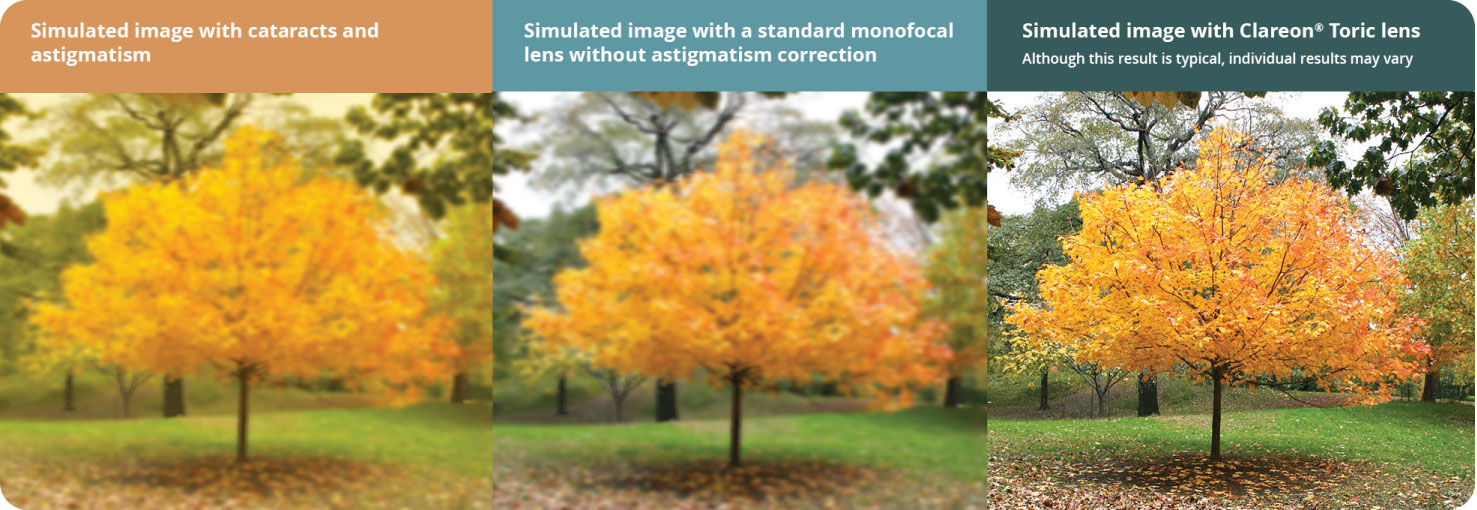 |
SEE THINGS DIFFERENTLY
AND CHANGE YOUR LENS ON LIFE
Start Your Journey Towards a Future Without Cataracts
You have a choice of cataract replacement lenses that can also correct your astigmatism, starting with the standard monofocal toric lens. With a Clareon® Toric lens, you can gain exceptional clarity for distance vision and correct astigmatism at the same time.1

Know Your Options,
Put Your Future in Focus
Here’s a visual example to help you understand the kind of vision improvements that come with a toric lens.

Toric lenses come in a range of vision options, from standard monofocal to advanced lenses. You have a choice when it comes to the right type of lens for you.
Frequently Asked Questions About Toric Intraocular Lenses
Get the information you need to guide you to an informed decision about toric lenses.
UNDERSTANDING CATARACTS AND ASTIGMATISM® VIVITY®?
Cataracts occur when proteins build up in your eye's natural lens, causing cloudy vision and making everyday tasks, like driving, using a computer, or recognizing familiar faces, more difficult.2
Astigmatism is a separate, common eye condition that happens when the cornea's surface has an uneven curvature, resembling a football rather than a basketball. This irregularity results in blurred vision at all distances and challenges in seeing fine details.2
By choosing a toric intraocular lens, you can effectively address the vision problems caused by cataracts and astigmatism simultaneously.1
WHICH ASTIGMATISM-CORRECTING CATARACT REPLACEMENT LENS IS RIGHT FOR ME?
The replacement lens you choose can have a big impact on what you can see and do post surgery. Talk to your surgeon; they can recommend the replacement lens that best fits your specific vision needs.
While Monofocal lenses are designed to improve distance vision only, Multifocal and Extended Depth of Focus (EDOF) lenses are considered advanced lenses and can reduce the need for glasses or contact lenses altogether.4-6 If that’s what you have in mind you may want to explore Clareon® PanOptix® Intraocular Lens or Clareon® Vivity® Intraocular Lens. Compare the lens technology between all of our Clareon® lenses here.
AM I A CANDIDATE FOR AN ASTIGMATISM-CORRECTING CATARACT REPLACEMENT LENS?
If you have cataracts and astigmatism, the answer is likely yes. Nearly 40% of people with cataracts also require astigmatism correction.3 Ask your surgeon if you're a candidate for any of the Clareon® astigmatism-correcting lens options.
Lead the Conversation
You have options when it comes to your intraocular lenses. Lead the conversation with your doctor to understand the cataract lens choice that’s right for you.
Find a cataract surgeon near you
Use our Cataract Surgeon Finder tool to locate a surgeon near you who offers a range of IOL options

IMPORTANT PRODUCT INFORMATION - CLAREON® FAMILY OF IOLS
CAUTION: Restricted by law to sale by or on the order of a physician.
DESCRIPTION: The Clareon® Family of Lenses are artificial lenses implanted in the eye of adult patients following cataract surgery. The Clareon® Aspheric Hydrophobic Acrylic IOLs are designed to allow for clear distance vision. However, you will likely still need glasses for reading and for distance vision particularly if you already have astigmatism. The Clareon® PanOptix® Trifocal Hydrophobic IOL is a type of multifocal lens (sometimes called “presbyopia-correcting IOL”) designed to allow for clear distance, intermediate, and near vision with the potential to be more independent of the need to use glasses for daily tasks. The Clareon® Vivity® Extended Vision Hydrophobic Posterior Chamber IOL provides clear distance vision, and better intermediate and some near vision compared to a monofocal IOL. The Clareon® Aspheric Toric, Clareon® PanOptix® Toric, and Clareon® Vivity® Toric IOLs are also designed to correct pre-existing corneal astigmatism, which is the inability of the eye to focus clearly at any distance because of difference curvatures on the cornea, and provide distance vision.
WARNINGS / PRECAUTIONS: You may experience and need to contact your eye doctor immediately if you have any of the following symptoms after cataract surgery: itching, redness, watering of your eye, sensitivity to light. The safety and effectiveness of these IOLs have not been established in patients with eye conditions, such as an increase in eye pressure (glaucoma) or complications of diabetes in the eye (diabetic retinopathy). As with any surgical procedure, there are risks involved. These risks may include but are not limited to infection, damage to the lining of the cornea, the retinal layer which lines the inside back wall of your eye may become separated from the tissue next to it (retinal detachment), inflammation or swelling inside or outside the eye, damage to the iris (the colored diaphragm around the pupil), or an increase in eye pressure that cannot be controlled by medicine and secondary surgical procedure. There is a possibility that the IOL may be placed incorrectly or could move within the eye. This may result in less improvement or a reduction in vision, or it may cause visual symptoms. The Clareon® Aspheric Toric, Clareon® PanOptix® Toric, and Clareon® Vivity® Toric IOLs correct astigmatism only when placed in the correct position in the eye. There is a possibility that these Toric IOLs could be placed incorrectly or could move within the eye. This may result in less improvement or a reduction in vision because your astigmatism has not been fully corrected, or it may cause visual symptoms. With the Clareon® PanOptix® and Clareon® Vivity® IOLs, there may be a loss of sharpness of your vision that may become worse in dim light or in foggy conditions. There is also a possibility that you may have some visual effects such as rings or circles (halos) around lights at night. You may also have trouble seeing street signs due to bright lights or glare from oncoming headlights.
ATTENTION: As with any surgical procedure, there are risks involved. Prior to surgery, ask your eye doctor to provide you with the Patient Information Brochure for the lens to be implanted. This Brochure which will inform you of the risks and benefits associated with the IOL. Discuss any questions about possible risks and benefits associated with your eye doctor.
REFERENCES
1. Clareon® Toric Directions for Use.
2. Cataracts. Mayo Clinic website. https://www.mayoclinic.org/diseases-conditionals/cataracts/symptoms-causes/syc-20353790. Updated June 23, 2018. Accessed April 6, 2021.
3. Núñez MX, Henriquez MA, Escaf LJ, et al. Consensus on the management of astigmatism in cataract surgery. Clin Ophthalmol. 2019;13:311-324. Published 2019 Feb 11.
4. Clareon® PanOptix® Trifocal Hydrophobic Acrylic IOL Model CNWTT0 2021.
5. Zhu D, Ren S, Mills K, Hull J, Dhariwal M. Rate of Complete Spectacle Independence with a Trifocal Intraocular Lens: A Systematic Literature Review and Meta-Analysis. Ophthalmol Ther. 2023;12(2):1157-1171.
6. Clareon® Vivity® Extended Vision Hydrophobic IOL (CNWET0) Directions for Use – USA.
